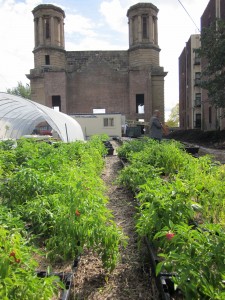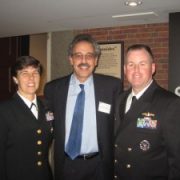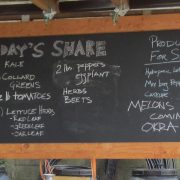
Does there seem to be a cultural zeitgeist about food these days? Food has always been a engrossing social topic of course, but between the First Lady’s vegetable garden, school lunch revolution movements, reality TV, and more, it seems that discussions of food and all its attendant concerns – health, nutrition, benefits of organic, agriculture policy, star chefs – are raging everywhere.
Even among museums.
I was delighted to discover, in the first post of 2011 on the Center for the Future of Museum’s blog, that museums, food and community will be one of their focus themes this year. No doubt we are all aware of and have seen many food-related exhibitions over the years, such as The Field Museum’s Chocolate show, or the Smithsonian’s own Key Ingredients: America by Food. We’ve all experienced many collections shows related to food, foodways programs, and museum cafes that reinforce missions, such as Mitsitam at the National Museum of the American Indian. But the specific inclusion of “community” as a component is an important one that seems to be gaining momentum and relevance in the museum field.
The CFM blog post links to an example of the Jane Addams Hull-House Museum in Illinois. But there are some great examples among Smithsonian Affiliates too.

Students learn about composting at Snug Harbor in NYC
At Snug Harbor Cultural Center on Staten Island in New York City, gardening is already an integral part of their identity. Their expansive grounds house an exquisite Chinese Scholar’s Garden, and a newly-opened Tuscan Garden, both authentic replicas of their international precedents. But their Compost program, and under-construction Sustainable Farm, are taking their commitment to gardens to the next level.
Working with the NYC Department of Sanitation’s Bureau of Waste Prevention, Reuse and Recycling, Snug Harbor’s Compost Project teaches community groups, teachers, and students through tailored hands-on workshops. In addition to exposing the benefits of composting, the workshops, classes and curricula foster a sense of environmental stewardship, uncover complex ecosystems, and explore soil and plant health. Now, in the same plot of land that historically was farmed to feed sailors, Snug Harbor will start plantings in the spring on its own Sustainable Farm. A brand new initiative, the farm is engendering ideas ranging from “grow a row” for classrooms, growing food for food banks, duplicating the Obama vegetable garden, and presenting exhibitions of artists who address ecosystems. “We want to create a triangle of programming,” says Patrick Grenier, Director of Visual Arts, “that combines our gardens, the farm, and [adjacent] gallery to present exhibitions and programs about horticulture.”

LPCCD's farm sits behind the historic church facade that serves as gateway to the neighborhood
At the Lincoln Park Coast Cultural District (LPCCD) in Newark, NJ, leaders have created a community farm in the iconic center of the neighborhood. LPCCD’s mission is to transform a low-income neighborhood from blighted lots into an urban eco-arts village. And they are doing it, in a completely holistic way. The neighborhood being created there is a mixture of LEED-certified housing units, green collar jobs, music festivals, historic restoration projects, a gallery, and eventually, a museum honoring African American music.
LPCCD’s community farm addresses a common issue raised in the healthy eating dialogue – that of fresh, natural food being affordable and available in low-income urban areas. Having just finished its first year, the farm promotes community supported agriculture (CSA) that enables city residents to have direct access to affordable ($40-80 per month) organic produce. What’s more, the choice of produce grown is customized to the area’s demographic and responds directly to what local consumers most want – mostly hearty greens, like collard and mustard. “People appreciate the value of the farm as an avenue to promote dialogue. They loved the space and came to share stories of their histories, their parents’ recipes. And they loved that something was growing in Newark, especially in our neighborhood,” according to Rob Wisniewski, Director Sustainable Development. In its second year, LPCCD plans to focus on education of the price value of the food, in terms of nutrition and environmental impact. They also hope to get the community even more involved by directing marketing efforts specifically to neighborhood stakeholders – the local school, restaurants, and residents. To entice participation, LPCCD hopes to offer personal plots to garden, as well as the CSA, and to tie the farm’s maintenance into their green jobs training program.

a shopper at Plymouth's Winter Farmers Market
Plimoth Plantation in Plymouth, MA is known for its historic foodways program. It is ground zero for Thanksgiving after all! Just last year though, Plimoth Plantation, which closes its living history exhibits for the winter, became home to the city of Plymouth’s winter farmers’ market once a month.
And now they are linking the farmers’ market to their mission and programming. This year, the Plantation is asking shoppers to bring their food to a communal “Cook Like a Pilgrim” program. Together, they will prepare and eat a meal of their local and seasonal foods, guided by the museum’s colonial foodways historian to make the whole event historically accurate and educational. “We like to think of ourselves as the hearth of the community,” says Jennifer Monac, Plimoth Plantation’s Public Relations Manager. “When examining the values and goals of the Farmer’s Market, it just seemed like a perfect fit to make Plimoth Plantation’s unique resources available to its participants.”
These projects (and no doubt countless others like it) exemplify the roles that museums can and do play as good neighbors and community partners. They reveal the creativity with which museum missions can extend beyond collections and exhibitions, using their sites and resources to fill community needs in the social and cultural fabric of their cities. And, they leave you hungry for more.






















